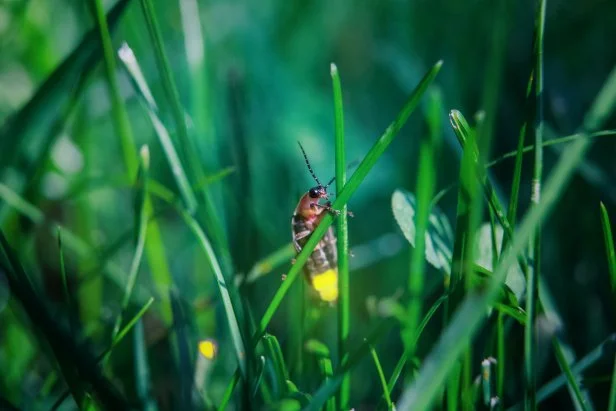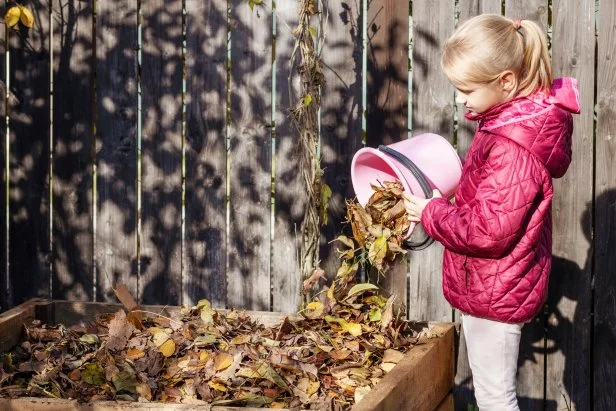| WHAT DOES 'LEAVE THE LEAVES' MEAN AND SHOULD YOU DO IT? Good news: If you’re tired of raking and bagging leaves, you'll be happy to know that October is "Leave the Leaves" month. Read on to learn some reasons not to clean up the fallen leaves and some practical tips for keeping your leaf-loving garden looking great.  Why Leave the Leaves?When the fall winds blow, so do the leaves from the oaks, maples and other trees in our yards and gardens. Simply leaving the fall leaves in your landscape has all kinds of benefits for the plants, shrubs and soil in your garden. Plus, piles of fallen leaves create winter habitats for all types of critters including butterflies, birds, fireflies, frogs and other non-human neighbors that make up a healthy ecosystem. Benefits to Your Garden
Benefits to WildlifeIn addition to all the ways that fall leaves can help make our gardens grow better, they also provide crucial food and habitat for all kinds of beneficial organisms that live in the landscape. Butterflies, birds, fireflies, amphibians and turtles are just a few of the animals that benefit from a healthy layer of leaves. According to Matthew Shepard, Director of Outreach & Education at the Xerces Society for Invertebrate Conservation, “All of the tiny life in the litter helps birds such as robins, song sparrows, towhees, and many others that hunt through leaf litter, as well as frogs and salamanders (eating worms, slugs, or insects) and chipmunks that rummage through litter for seeds, nuts, mushrooms, insects, worms, and more.” Help Butterfly + Moth LifecyclesIt’s easy to get excited about planting showy flowers that attract colorful butterflies into our yards. While adult butterflies, moths and skippers are pollinators that spread pollen between flowers in our gardens, it’s also important to plan around the other stages of the lepidopteran lifecycle. Adults lay their eggs on the leaves of an appropriate host plant — that is, a species of plant that caterpillars are able to digest. For example, Luna moths (Actias luna) lay their eggs on broadleaf deciduous trees like birch, sweetgum and persimmon. From the time that they hatch until they pupate, caterpillars essentially just eat leaves.  Special Beauty While leaving the leaves is important for the caterpillar and cocoon stages, adult butterflies like the Eastern comma (Polygonia comma) and the Question Mark butterfly (P. interrogations) (pictured above) overwinter in the leaf litter below trees, disguised as dried, dead foliage. Numerous species of lepidopterans — especially those that are associated with tree species — stay close to their host tree. Their caterpillars descend from the tree canopy before pupating, either by slowly inching down the trunk, gently lowering itself on a thread of silk or taking a leap of faith, trusting that there’s a soft bed of leaves below. Once on the ground, some caterpillars, including sphinx and hawk moths (family Sphingidae), pupate under the soil. Others, including Luna, polyphemus (Antheraea polyphemus) and io moths (Automeris io), choose to camouflage their cocoon in the leaf litter under the tree. Feed Birds, Frogs + MoreProviding habitat for the entire butterfly and moth lifecycle is important for more than just butterfly enthusiasts. Insects — especially soft-bodied caterpillars — are a crucial food source for adult birds and nestlings, as well as many other friendly garden neighbors, like frogs, salamanders, skinks and lizards. Leaving the leaves will help butterflies complete their lifecycle and feed other members of your garden’s ecosystem.  National Wildlife Federation/Melanie Kelley Soft-bodied caterpillars that overwinter in leaf litter are a crucial food source for adult birds and nestlings, as well as many other friendly garden neighbors, like frogs, salamanders, skinks and lizards. Leaf Litter Helps Fireflies Light UpLeaf litter is also an important habitat and hunting ground for fireflies. Like butterflies, fireflies also metamorphosize, going from egg to larvae, pupa to adult. The familiar adult phase at the end of the firefly’s life is brief, lighting up our gardens for only two to four weeks, depending on the species. However, firefly larvae can live between two and four years, prowling in moist leaf litter in search of slugs, snails and earthworms to feed on.  Suzanne Tucker Be sure to leave a patch of fall leaves for firefly larvae habitat if you want the fireflies to illuminate your garden on summer evenings. Be sure to leave a patch of fall leaves as firefly larvae habitat if you want the adults to illuminate your garden on summer evenings. "Leaf litter and leaf piles can be great places for fireflies and can be created in gardens of any size," explains Matthew. "You may not have space for a pond, but you could have a small pile of leaves in the back corner." Check out Conserving the Jewels of the Night: Protecting Fireflies in the United States and Canada from the Xerces Society for more information. Help Amphibians + Reptiles Hibernate Wonderful Works Frogs and turtles often burrow below the leaves in winter to hibernate. Many amphibians and reptiles have special camouflage that allows them to easily hide from predators among the leaves. Adding a healthy layer of leaf mulch is a great way to provide food and habitat for land-dwelling frogs, salamanders, turtles and other cold-blooded neighbors. These beneficial critters prey on slugs, snails and insects in the garden. The shade and humidity found in the leaves protect amphibians from drying out in the summer. Frogs and turtles often burrow below the leaves in the winter before hibernating. Plus, many amphibians and reptiles have special camouflage that allows them to easily hide from predators among the leaves. Practical Tips for Leaving the Leaves"Honestly, there is no absolute right or wrong way to leave the leaves," says Matthew. "Like any other element of gardening, it is something that you’ll adapt to your garden and desires. There is certainly no need to keep all the leaves that accumulate and don’t keep them where they will be a problem for you (slipping hazard, blocked drains)." Avoid Foundation BedsWhile most of us have garden beds right next to the house, these foundation plantings are not the best spot to leave the leaves for a couple of key reasons. First, dried, dead leaves are an ignition hazard — especially early in the fall before the leaves begin to decompose. It’s best to avoid using fresh fall leaves as mulch in garden beds next to the house, porch and wood fences, and it’s a good idea to remove or relocate leaves that may blow and accumulate next to those structures. In their book Firescaping Your Home: A Manual for Readiness in Wildfire Country, Adrienne Edwards and Rachel Schleiger recommend folks in fire-prone areas avoid gardening within 5 feet of their homes, keeping that area clear of plants, organic mulch and any other combustible materials. Second, leaf litter can harbor undesirable ticks, which may carry diseases like Lyme disease, Rocky Mountain spotted fever, and other tick-borne illnesses. The University of Connecticut’s Tick Management Handbook recommends flipping the landscape, moving garden beds away from the house and high-traffic areas, with 3-foot wide wood chip barriers between gardens and wooded spaces that may harbor ticks. Don't Let Leaves Into Storm DrainsAvoid letting leaf piles get into storm drains. Leaves pollute urban stormwater with excess phosphorous when they pile up in storm drains and street gutters. Leave the leaves in your yard on a soft substrate where the phosphorous can absorb won't cause that problem. Create “Soft Landings” Oasishifi Caterpillars descend from the tree canopy before developing into butterfly or moth larvae by slowly inching down the trunk, gently lowering themselves on a thread of silk, or taking a leap of faith, trusting that there’s a soft bed of leaves below.
Fortunately, the areas where leaving the leaves can have the greatest impact on butterflies, fireflies and other beneficial organisms aren’t usually right next to the house. Instead, consider creating garden beds below and around the canopy of trees and shrubs, which will provide a “soft landing” area for caterpillars that drop out of the canopy. Choose shrubs, flowering perennials or ground cover species that will tolerate the soil, moisture and sunlight conditions in the space below and around the tree trunk. If you’re planting around a shallow-rooted species, like maples (Acer spp.), start with smaller plants that will require smaller holes — this will minimize root disturbance to the tree. If starting a leaf pile under a tree is not an option, pick a corner of the yard or any out-of-the-way place to start a leaf pile. "You can keep them wherever you have space," explains Matthew. "Given the diversity of invertebrates and the myriad variety of conditions that different species might prefer, almost anywhere you have them will bring benefits. Also, the effects of sun exposure or rain or frost will be limited to the outer layers of the leaf pile. Inside the dark dank musty depths, the conditions are fairly consistent." How Long Should You Keep a Leaf Pile? Mariana Serdynska Collect leaves in an open-top compost bin or raised garden bed. You'll be helping the natural habitat of your backyard and at the end of a year, the leaves should have broken down into rich and crumbly leaf mold that can be spread as mulch on your garden beds around perennials, trees and shrubs or mixed into the vegetable garden. Forever. Don't rake up your leaf pile in spring, keep it all year to benefit wildlife and once it breaks down, you can use it as mulch. "The ideal is to decide where you can keep leaves and leave them all year," explains Matthew. "I have a pile at the base of a hedge beside my driveway where I rake leaves off the drive. That mound has been there for years. It grows in fall and shrinks through the rest of the year — and has all sorts of interesting critters in it. I also use them as mulch on flower borders." Leaves: To Shred or Not to Shred?It’s best for overwintering butterflies, frogs and other beneficial species to avoid shredding or mowing over fall leaves if at all possible. Leaf shredding can destroy cocoons and organisms that are hibernating and camouflaged in the soil while leaving the leaves offers winter habitat protection. However, there may be instances where shredding, at least of some of the leaves, can be more practical. Leaves in windy areas or on sloped sites may be easily blown away to other areas of the garden, neighboring gardens or even further away. Trees with especially large leaves, like bigleaf magnolia are more likely to be blown out of the garden bed. Relatively thick, waxy leaves, like many species of oak, may take longer to decompose and are more prone to blow away later in the season. Mulching or selective shredding allows these kinds of leaves to break down more quickly, making them less likely to blow away. Another option is to make your own leaf mold. This practice is less destructive and labor-intensive than leaf shredding, and the end result is a rich mulch or soil amendment. If wind isn’t a problem in your garden, you can simply rake the leaves into a pile in a remote corner of the yard. If wind is a problem, you can build a simple holding pen using chicken wire and fill the pen with fall leaves. At the end of a year or so of natural decomposition, the leaves should have broken down into rich and crumbly leaf mold that can be spread as mulch on your garden beds around perennials, trees and shrubs or mixed into the vegetable garden or other annual plantings. To speed the process up, simply water and turn the pile every few weeks. |
|
|||||||||||||
|
|||||||||||||||||||||||||||||||||||||||||||||||||||||||||||||||||||||||||||||||||||||||||||||||||||||||||||||||||||||||||||||||||||||||
|
|||||||||||||||||||||||||||||||||||||||||||||||||||||||||||||||||||||||||||||||||||||||||||||||||||||||||||||||||||||||||||||||||||||||
|
|||||||||||||||||||||||||







